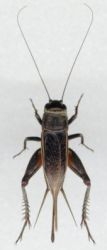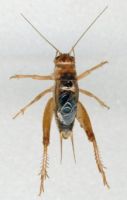Crickets

Field Crickets
 Description:
Description: Field crickets are black or dark brown insects about 1 inch long as adults. They have large hind legs (for jumping) and most have well-developed wings. Nymphs are similar but are smaller and lack wings. Both have long, slender antennae.
Distribution and Hosts: Various species of field crickets occur over most of the United States and all of Oklahoma. We believe there are five species in eastern Oklahoma and at least two of these occur in the western part of the state. Field crickets will feed on almost anything. They occasionally damage cultivated crops such as alfalfa, cotton, and strawberries. They can also damage vegetables and ornamentals when they are numerous.
Damage : The major importance is as a nuisance pest when they come to lights in homes and urban areas during periods of high abundance. Their chirping or mere presence is a nuisance to some. Also, they will sometimes damage fabrics, especially if soiled, and may chew on wood, plastic, rubber, or leather goods. The most serious outbreak in recent years occurred in 1953 when large numbers of crickets invaded cities and towns in many parts of Oklahoma and surrounding states. One report stated, "During warm nights, the streets beneath bright lights were black with crickets, sides of buildings were completely covered with tremendous numbers of the pests, and some streets were hazardous for driving due to the slipperiness caused by the crushed crickets."
Life Cycle: The eggs are usually laid in the soil. The newly hatched nymphs burrow to the surface. They will molt 8 to 10 times over a period of 2 to 3 months before becoming adults. One species overwinters as nymphs and the adults are present in the spring and early summer. Others overwinter as eggs and adults are present during the summer and fall. In certain years, field crickets appear in very large numbers during August and September. These outbreaks seem to occur after periods of prolonged dry weather in the spring and early summer followed by rainfall in July and August. Extensive soil cracking may be an important factor. Good sites for egg deposition, an abundance of favorable food, vegetation for shelter, and a scarcity of parasites and predators may also be involved.

Shorttailed Crickets
 Description: These crickets are similar to field crickets except for the short ovipositor from which they get their name shorttailed. They are light brown in color with a body length of about 3/4 inch. They shed the hindwings soon after becoming adults and never fly. Nymphs are smaller than adults, light brown in color, and lack wings. These crickets feed on grasses, weeds, and pine seedlings. Their damage to turf grasses by feeding is apparently negligible.
Description: These crickets are similar to field crickets except for the short ovipositor from which they get their name shorttailed. They are light brown in color with a body length of about 3/4 inch. They shed the hindwings soon after becoming adults and never fly. Nymphs are smaller than adults, light brown in color, and lack wings. These crickets feed on grasses, weeds, and pine seedlings. Their damage to turf grasses by feeding is apparently negligible.
Life Cycle: Shorttailed crickets overwinter as nymphs in burrows in the soil. After several molts in early spring, they reach the adult stage. Mated females begin to lay eggs in late spring or early summer. Hatching takes place in a multi-chambered burrow constructed by the adult. For a short period of time, both eggs and nymphs may be found in the burrow. Between the fourth and sixth instars, nymphs leave the parent burrows and construct burrows of their own. At first the burrows are small, but as the crickets mature the burrows are enlarged and may reach depths of 12 to 20 inches. Only one cricket is found per burrow except for the time when certain burrows contain eggs and nymphs. There is one generation per year.
Damage: In turf, burrows constructed by the nymphs and adults result in unsightly mounds of small soil pellets which may smother the surrounding grass. In Oklahoma, they are seldom noticed until the maturing nymphs begin to construct new burrows in the late summer. This is usually sometime in August and activity continues through October and, in some years, through most of November. The burrows are rebuilt each time they are washed away by fall rains.
 Description: Field crickets are black or dark brown insects about 1 inch long as adults. They have large hind legs (for jumping) and most have well-developed wings. Nymphs are similar but are smaller and lack wings. Both have long, slender antennae.
Description: Field crickets are black or dark brown insects about 1 inch long as adults. They have large hind legs (for jumping) and most have well-developed wings. Nymphs are similar but are smaller and lack wings. Both have long, slender antennae. Description: These crickets are similar to field crickets except for the short ovipositor from which they get their name shorttailed. They are light brown in color with a body length of about 3/4 inch. They shed the hindwings soon after becoming adults and never fly. Nymphs are smaller than adults, light brown in color, and lack wings. These crickets feed on grasses, weeds, and pine seedlings. Their damage to turf grasses by feeding is apparently negligible.
Description: These crickets are similar to field crickets except for the short ovipositor from which they get their name shorttailed. They are light brown in color with a body length of about 3/4 inch. They shed the hindwings soon after becoming adults and never fly. Nymphs are smaller than adults, light brown in color, and lack wings. These crickets feed on grasses, weeds, and pine seedlings. Their damage to turf grasses by feeding is apparently negligible.